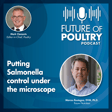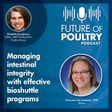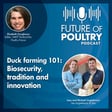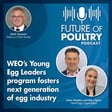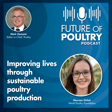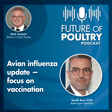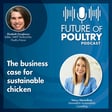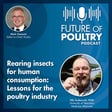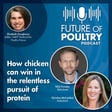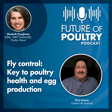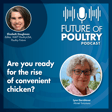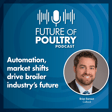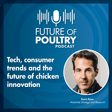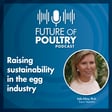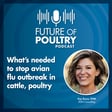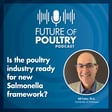Become a Creator today!Start creating today - Share your story with the world!
Start for free
00:00:00
00:00:01

Phage therapy in the poultry industry
Mark Clements talks to Pablo Cifuentes, chief technology officer with PhagLab, about phages and how and why their use in the poultry industry is set to increase.
Transcript
Introduction to the Podcast
00:00:00
Speaker
Hello and welcome to the Future of Poultry podcast series. Hello and welcome to the Future of Poultry podcast. I'm your host, Mark Clements, Editor-in-Chief Poultry with What Global Media.
What is Phage Technology?
00:00:22
Speaker
And today we're going to talk about phages with Pablo Cifuentes, Chief Technology Officer with Santiago de Chile-based company PhageLab. Phage technology is a particularly interesting area. Bacteria phages were first discovered a little over a century ago and became a way of treating bacterial infections. But in most of the world, their use never became widespread.
00:00:46
Speaker
This is now changing, driven in large part by the need to find alternatives to antibiotics, but there remain difficulties in bringing them to market.
Meet Pablo Cifuentes
00:00:56
Speaker
Earlier this year, PhageLab registered the first phage product against E. coli in Brazil, and we'll talk about that later on. But first, let's welcome our guest today, Pablo Cifuentes. Hello, Pablo.
00:01:09
Speaker
Thank you so much for joining us today. Thanks to you. Pablo, before we really look at what a phage is and look in more detail at their benefit to the poultry industry, perhaps you could tell us a little bit about yourself, your role in phage lab and perhaps how phage lab came about. Yeah, of course. Well, I am engineering biotechnology. I'm from Chile.
00:01:32
Speaker
I have a couple of masters in science and innovation and my background is related to microbiology, molecular biology and stuff like that. Okay. So my role in the company is very simple is to develop and create the technology to seek and destroy bacteria for animal health. So currently I'm the leader of a team of about 50 people to identify
00:02:02
Speaker
a target bacteria, develop a product against that bacteria, and finally get the regulatory approvals so that that product can be sold in that market, in the target market.
PhageLab's Journey
00:02:15
Speaker
So what about the phage lab origins? Well, when we finished our biotechnology thesis, we decided to build a company to develop products based on phages.
00:02:28
Speaker
which are viruses that specifically kill bacteria. We use that concept to create a ph product in powder against H.C. that is a bacteria that sometimes cause problems in humans. And we create that product to clean vegetables in kitchens, you know, so literally
00:02:51
Speaker
dilute this product in water, clean your lettuce, and keep you from getting sick to your stomach from E. coli. The product failed miserably because there's no market for a vegetable disinfectant. And of course, the problem was very poorly stated. Great scientists, but very bad
00:03:20
Speaker
salesmen. However, one farmer had access to this product, gave it to his dairy cows. And the consequence was reduction of the mortality, increase the weight gain, and finally, increase the milk production of those dairy cows.
PhageLab in Poultry
00:03:43
Speaker
So at that point, weeks away from bankruptcy, we became an animal health company.
00:03:50
Speaker
Then Bayer Animal Health began to distribute this product in several countries, this product for ruminants. We expand our portfolio to other applications such as broilers, chickens. And today we are implementing features in the largest chicken producers in Brazil. So that is the one decade in one minute.
00:04:18
Speaker
Interesting company history. So turning specifically to phages now, could you tell us simply what a phage is and how it works against bacteria?
How Do Phages Work?
00:04:31
Speaker
Phages are viruses that specifically identify, interact and destroy bacteria. Phages are in the nature, so
00:04:43
Speaker
We can identify those features, isolate them, and use it as a tool to kill bacteria that are causing a problem. The challenge is to identify an efficient fate to kill a pathogenic bacteria without causing problems to other bacteria that are beneficial for the animal in this case that we are treated.
00:05:13
Speaker
So basically it's that, a virus. The benefits of those viruses are first safety. If we isolate the correct phage, we can kill only pathogenic bacteria without causing problems in the normal flora. Then the efficiency
00:05:38
Speaker
there are highly specific and highly efficient killing bacteria from the inside of the bacteria. And finally, the production. We can produce a lot of fetches in a small volume, so you can use in a small quantity of fetches to kill bacteria. In terms of how they work specifically, fetches interact with the bacteria,
00:06:09
Speaker
When they find this bacteria, the phage introduce the genetic material of that phage inside the bacteria and then use the machinery of the bacteria to replicate and produce clones of that phage. And finally, that phage will destroy that bacteria from the inside using enzymes that cut the bacteria membrane.
00:06:37
Speaker
So the clones of that fetch will repeat the same process until the bacteria disappear from that tissue organ or animal. Thank you. So we know that where antibiotics are concerned, there are ever more restrictions, but poultry producers are familiar with them and they know that they work and they're widely available.
00:07:04
Speaker
So why should our listeners be interested in trying phages?
Benefits of Phage Use
00:07:10
Speaker
Excellent question. First, there's a lot of skepticism related to the use of phages. Why? Mainly because there's a lack of published results in farms. Phages are not new. It's a technology that was discovered in the 20s. So there's a lot of evidence
00:07:33
Speaker
in the laboratory, but not so much in farms. We have the evidence of the use of fetches in farms. So with those results, we can have an impact in the efficiency and in the production. That is what the farmers want. Secondly, fetches can be used in synergy with
00:08:03
Speaker
other products like antibiotics and like vaccines. So you can have better results if you use these products or fetch products as a new tool and as a complement in order to reduce the quantity and the frequency of antibiotics. And the third point is that
00:08:34
Speaker
The antibiotics are not useful anymore for some indications. There are many, many bacteria that are multi-resistant to every antibiotic available in the market and sometimes are resistant to disinfectants. So in that sense, there's a lack of tools to eliminate or control those multi-resistant bacteria.
00:09:03
Speaker
and phages can kill those bacteria and give the farmers a result that they never had in the past. So when it comes to really understanding phage therapy, this might be via a single strain of phage or perhaps a phage cocktail.
Single vs Cocktail Phage Approach
00:09:25
Speaker
Could you explain to us what the difference is? Yes.
00:09:29
Speaker
One single phage can destroy more than one bacteria, but the phage are so specific against bacteria that sometimes you need more than one phage to have coverage. So if we have 100 targets, we probably will need more than one phage to have to cover all the strains that are causing the problem.
00:09:58
Speaker
Also the use of a cocktail allow us to reduce the probability of resistant bacteria because the bacteria can develop resistance to the phage, number one, but the phage number two will kill the bacteria or the phage number three or the phage number four. So the best approach for the phage therapy is use a cocktail
00:10:27
Speaker
to amplify the efficacy, improve the coverage, and reduce the resistant bacteria scenario. I see. So how do you go about finding a combination of phages that work together?
Predicting Phage Combinations
00:10:44
Speaker
I'm imagining this must be quite a lengthy process. Totally.
00:10:51
Speaker
The first approach that we developed was related to scientists isolating a phage from the nature and test, empirically, that phage against a collection of bacteria. So when we receive a collection of bacteria from a client in Brazil, Chile, Mexico, the United States, 500 different strains, the first approach is to test
00:11:17
Speaker
the 500 strains against our collection of fetches and developed cocktail. We have more than 600 fetches in our collection, so make every interaction of the 500 strains against the 600 fetches is impossible beautifully and physically. So we invent a second approach that is a prediction of the best probable
00:11:45
Speaker
combination of cocktails of our collection against the target strains. So we use the genetic information of the target bacteria. We use the genetic information of orophages. And finally, we use the third component that is the historical interaction between orophages and a similar bacteria. So with that,
00:12:15
Speaker
This machine learning algorithm give us a prediction of the top 10 fetches to be used against those bacteria. And we finally, we test in the laboratory and we have a 90% of accuracy. So that is a great asset for us because we don't lose time using bad fetches. And we use all our machinery, our infrastructure
00:12:44
Speaker
and our human resources in the correct ages.
Targeting Salmonella and E. coli
00:12:52
Speaker
Yes, 4.3, we are targeting two bacterias for two different problems.
00:13:03
Speaker
The first bacteria is salmonella that cause a problem of the sole presence of salmonella. Salmonella is asymptomatic in the chicken, but contaminates the meat of the chicken. So we try to reduce the presence of salmonella in order to impact in the slaughterhouse and reduce the presence in the meat. Secondly, E. coli.
00:13:31
Speaker
in chickens, that is a very different problem. E. coli cause mortality in the chickens. So the farmers are using right now some vaccines and some antibiotics without success. So we make a product against that pathogenic bacteria to reduce the mortality and the symptoms. For ruminants, we have a product against E. coli and salmonella in the same product. Those two bacteria
00:13:59
Speaker
cause diarrhea in dairy cows in the first 60 days of life. So we use that cocktail to kill E. coli and salmonella at the same time and reduce the symptoms and in order to improve the weight gain of the dairy cow.
00:14:19
Speaker
And so those are the two worlds that we are working right now.
Regulatory Success in Brazil
00:14:23
Speaker
So you've just mentioned E. coli, and as I mentioned earlier, you recently registered a phage product for use in poultry against E. coli in Brazil, and it was the first E. coli phage product to be registered there. Can you tell us about that registration?
00:14:39
Speaker
Yeah, of course. That product is called formula. Formula is a liquid feed additive of a fetch cocktail to reduce the mortality and symptoms caused by E. coli and that is a very different strain. That is an ambient pathogenic E. coli in broilers.
00:14:58
Speaker
that is a cocktail of different features, specifically developed to kill the high risk E. coli that is causing very serious problems in Brazil. We were the first registered product against that problem in Brazil. It was a very long journey because we need a lot of evidence in vivo. That means in animals,
00:15:28
Speaker
So we execute safety experiments in Europe, efficacy experiments also in Europe, and some experiments in Brazil and in Chile. So it was a lot of hard work, but the result was very successful. And right now we are implementing that product in Brazil without recession of the regulators. And we are seeing great results. So we're very happy with that.
00:15:56
Speaker
Well, many, many congratulations on the registration. It leads me to an interesting point that registration difficulties are among the main hurdles, really, that phages face in reaching the market. That's correct, isn't it? Yes, it's correct. In fact, the registration is one of the last gaps or challenges in order to the market fit. If you don't have the registration, probably you will not have sales in every market in the world.
00:16:26
Speaker
So yeah, there's a lot of.
00:16:28
Speaker
difficulties, especially in phages, because phages are viruses that are not alive, sometimes are alive. The legislation is not so clear about the use of phages. So you need to find the best way in order to get the registration. But we have an internal regulatory affairs team. So that team is very close to the regulators in Brazil, the United States, and in every market that we are making sales or implementations.
00:16:57
Speaker
So there is a relation that you need to establish in order to get the registration and in order to know the requirements because sometimes there are very expensive requirements to fulfill and sometimes they are not. But making that with time you can get the registration so we are very
00:17:16
Speaker
successful in that way because we know the strategy to get the registration and access to the market. Excellent. Thank you.
Funding and Expansion Plans
00:17:24
Speaker
Now, returning specifically to PhaseLab, I believe you managed to achieve a significant amount of funding earlier this year. Could you give us some details of how that came about and how it will take your work forward? Yeah, totally. Right now we get funding mainly because we pass from a
00:17:44
Speaker
pre-operational stage to an operational stage. Happily because that means that the product that we develop in technology is working. So right now we need money to implement that product in Brazil that is a big market. Right now we have projects with our clients that with a total of 500 million chickens in different parts of Brazil.
00:18:10
Speaker
So that means that we need a lot of resources to put the bottles of fetches in every farm to fulfill that demand. That is a great challenge. So in order to execute that plan, we made an extension of a Series B that we executed two years ago. We did a funding round of $11 million and that money will be enough to cover that operation
00:18:40
Speaker
and that is very big in Brazil, so we are very happy with that also. Congratulations, excellent. Now I just have one or a couple of final questions for you if I
Future of Phages in Poultry
00:18:52
Speaker
may. In your view, how do you see the market for phages developing and do you think that phages will be much more widely used in the poultry industry in the future and more broadly used?
00:19:03
Speaker
Yeah, totally. I mean, starting with the second part of the question, totally agree that the fetches will be widely in the poultry industry and in the future, especially for humans or other indications in animal health. The regulation is changing. In Europe, already changed to improve their registration process for fetch-based products. And that is a great signal from a very big market
00:19:33
Speaker
high regulated market that is Europe. And with that said, I see that the future of phage development is needs to see the reality of the use of the phage, especially where you need to use that phage. We don't need more evidence only in vitro, that means in the laboratory. If a product works in the laboratory, that doesn't mean that we work in the farm.
00:20:03
Speaker
or in a human, if you access to a product in the farm and in the drug store, for example. So you need evidence in vivo, in the farm, in productive conditions. So all the groups and academics and the companies like PhageLab understand that right now, and we are generating more evidence from that perspective.
00:20:29
Speaker
And also, one thing that is changing is that in the last five years, we are talking more about the synergy of phages with the available tools like antibiotics and vaccines. There's a lot of evidence that phages plus antibiotics work better. That is a fact.
00:20:56
Speaker
So in the last five years, we stopped to say that the phages will substitute the antibiotics because that is a bad claim. Phages are a new tool, a great tool to solve problems and antibiotics. If you use it wisely, it's the same thing. It's an old tool, but if it
00:21:20
Speaker
with different results and to solve problems. So that's it. I'll see the future very bright, in fact, for phage
Podcast Conclusion
00:21:28
Speaker
therapy. Well, Pavlov, thank you so much for joining us today and for talking about the growing area of phages. Listeners, thanks to all of you for listening and do look out for other editions of our podcast, The Future of Poultry. Once again, Pavlov, thank you very much. Thank you very much to you.

